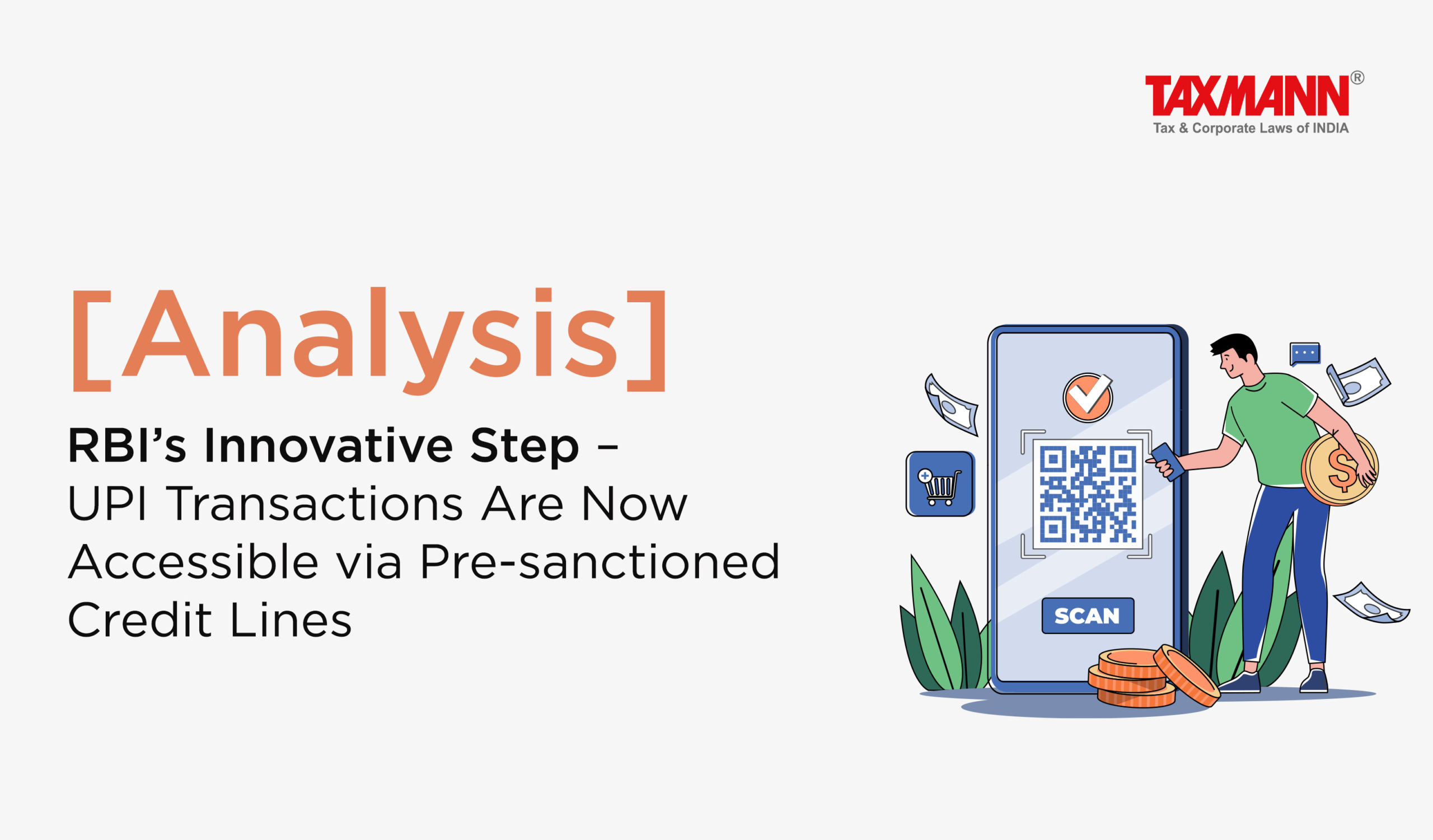[Analysis] RBI’s Innovative Step – UPI Transactions Are Now Accessible via Pre-sanctioned Credit Lines
- Blog|Advisory|FEMA & Banking|
- 2 Min Read
- By Taxmann
- |
- Last Updated on 25 April, 2024
Table of Contents
- Background
- RBI’s proposal to expand the scope of UPI
- RBI makes pre-sanctioned credit Lines at banks operational using UPI
- RBI directs banks to finalize credit terms in accordance with Board- approved policy
1. Background
Unified Payments Interface (UPI) is a robust payment platform with diverse capabilities, currently facilitating 75% of India’s retail digital payments. It has played a pivotal role in aligning its products and features with India’s digital payment objectives. Recently, RuPay credit cards were permitted to be linked to UPI.
Presently, UPI transactions take place between deposit accounts at banks, sometimes intermediated by pre-paid instruments including wallets. As of now, only savings accounts, overdraft accounts, prepaid wallets and credit cards can be linked to UPI.
2. RBI’s proposal to expand the scope of UPI
The Reserve Bank of India, vide Statement on Developmental and Regulatory Policies dated April 06, 2023, proposed expanding UPI’s scope by enabling transfer to or from pre-sanctioned credit lines at banks, in addition to deposit accounts.
In simpler terms, the UPI network will facilitate payments backed by bank credit, potentially lowering costs and fostering the creation of innovative products tailored for the Indian market.
3. RBI makes pre-sanctioned credit Lines at banks operational using UPI
The RBI has permitted transactions to or from pre-sanctioned credit lines at banks through the UPI system. Under this facility, payments through a pre-sanctioned credit line issued by a Scheduled Commercial Bank to individuals, with prior consent of the individual customer, are enabled for transactions using the UPI System. This measure can reduce the cost of such services and help in the development of unique products for the Indian market.
4. RBI directs banks to finalize credit terms in accordance with Board- approved policy
Banks may stipulate the terms and conditions of using these credit lines in accordance with their Board-approved policies. These terms may include various aspects including the credit limit, period of credit, interest rate, etc.
Impact
In conclusion, the RBI’s recent move to expand the scope of the UPI platform by allowing transactions from pre-sanctioned credit lines at banks is a significant step forward in advancing India’s digital payment landscape.
This development not only enhances the versatility of UPI but also has the potential to reduce costs and encourage the creation of innovative financial products tailored specifically for the Indian market.
By enabling payments backed by bank credit, this initiative aligns perfectly with the country’s digital payment objectives, making UPI an even stronger and more inclusive payment platform for the benefit of individuals and businesses across India.
The RBI’s initiative to incorporate pre-sanctioned credit lines into the UPI platform stands as a cornerstone in India’s digital payment evolution. It signifies a pivotal shift towards a more inclusive, efficient, and innovative digital payment ecosystem in India.
Disclaimer: The content/information published on the website is only for general information of the user and shall not be construed as legal advice. While the Taxmann has exercised reasonable efforts to ensure the veracity of information/content published, Taxmann shall be under no liability in any manner whatsoever for incorrect information, if any.

Taxmann Publications has a dedicated in-house Research & Editorial Team. This team consists of a team of Chartered Accountants, Company Secretaries, and Lawyers. This team works under the guidance and supervision of editor-in-chief Mr Rakesh Bhargava.
The Research and Editorial Team is responsible for developing reliable and accurate content for the readers. The team follows the six-sigma approach to achieve the benchmark of zero error in its publications and research platforms. The team ensures that the following publication guidelines are thoroughly followed while developing the content:
- The statutory material is obtained only from the authorized and reliable sources
- All the latest developments in the judicial and legislative fields are covered
- Prepare the analytical write-ups on current, controversial, and important issues to help the readers to understand the concept and its implications
- Every content published by Taxmann is complete, accurate and lucid
- All evidence-based statements are supported with proper reference to Section, Circular No., Notification No. or citations
- The golden rules of grammar, style and consistency are thoroughly followed
- Font and size that’s easy to read and remain consistent across all imprint and digital publications are applied






 CA | CS | CMA
CA | CS | CMA


